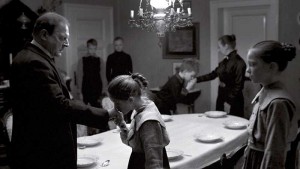During a mid-nineties Charlie Rose interview, Quentin Tarantino claimed that his practice with new works from filmmakers he loved (Brian DePalma was his example) was to see the film several times before coming to an opinion on it. His solid reasoning is that it takes a viewing or two to understand the story and the characters and at that point he could then focus on technique or what else the movie might be saying. Had I the time and opportunity to apply this to the directors I love (and still manage to see anything else), Michael Haneke would be on even the shortest list that would require such filmgoing rigor. In fact, there’s no movie I’ve seen in a theater more than his original Funny Games and I was so amazed after my first viewing of The Seventh Continent that I went back and saw it the following night. I write here after my first viewing of White Ribbon, Haneke’s latest and a work deserving of multiple viewings, currently playing at Film Forum and Lincoln Plaza.
White Ribbon is like a confounding puzzle that remains unsolved (similar to Cache and Code Unknown in that way). The story centers on a small German village on the eve of World War I. While the action takes place in chronological fashion and there is narration—the memories of elderly man who we see as a young school teacher in the story—the movie is intentionally never clear or straightforward. Often we see images that are not explained or the significance of which is not revealed until much later in the film. The thread that ties them together is a series of events demonstrating the brutality of the villagers, including a mystery surrounding several acts that appear to be attempts at homicide. Shot in stark black and white, the film depicts the actions with most of the violence (again, like Funny Games) happening off screen and with barely a drop of blood or scratch on its victims.
Haneke’s work brilliantly operates on two levels. Often he delivers a movie—a thriller, usually—that can be enjoyed as a genre piece by a masterful manipulator. Another level of aesthetics and subtext usually provides more to chew on and often more manipulation, notably direct audience addresses (implications? attacks?) that make him such a divisive artist. With White Ribbon, the genre fan enthusiast is certain to be confounded; the story’s key mystery remains unsolved, major story elements are skipped or told in passing narration. The deeper level lovers of Haneke may be driven just as crazy. The simple read of the film is that it is showing the atmosphere that will lead to the German atrocities of the next generation—the film is subtitled “A Children’s Story”—but there are so many more themes at work here—rites of passage, religion, repression, authority figures, male and female roles in society. My desire for multiple viewings is to put these themes into a greater context. In one of my favorite scenes, the narrator-as-a-young-man takes a carriage ride with his fiancée, their suppressed/repressed romance one of the few rays of light in the film. Steering the carriage off the intended path, tension grows as it seems the school teacher has decided upon an unexpected physical act. His fiancée pleads with him to turn back, but he calmly insists that he is only taking her to a secluded picnic spot. They partake in their first kiss and continue. We never are sure of his actual intentions, nor do we even find out what happens. We are left to determine what his dogged determination means? Is it an act of desire, love, an untying repressive binds, a rite of passion? Does her kiss indicate that she has given in to his desire? It is easy to withhold narrative information, the achievement is getting us to care enough to put it all together.

